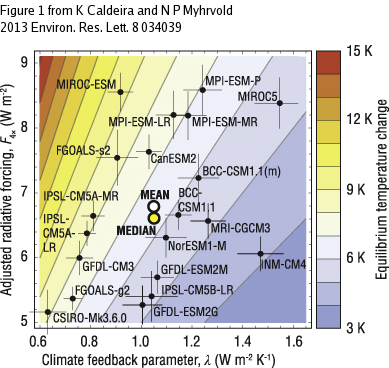Most research has focused on the amount of global warming resulting from increased greenhouse gas concentrations but there has been relatively little study of the pace of the change following these increases.
A new paper concludes that about half of the warming occurs within the first 10 years after an instantaneous step increase in atmospheric CO2 concentration, but about one-quarter of the warming occurs more than a century after the step increase. The authors used results from the majority of the world's leading climate models - over 50 climate simulations, which were performed using 20 different climate models for the Climate Model Intercomparison Project, Phase 5 (CMIP5).
They found a fairly high degree of consensus on the general character of the pace of climate change. In response to an instantaneous increase in greenhouse gas emissions, climate change is fast out of the starting gate but then slows down, and takes a long time to approach the finish line.
There is substantial quantitative disagreement among climate models, however.

The climate feedback parameter (λ, horizontal axis), adjusted radiative forcing (F4×, vertical axis), and equilibrium temperature change (ΔT4×, contours) for the 20 models submitting output to CMIP5, as calculated from abrupt4xCO2 simulations that posit an instantaneous four-fold increase in atmospheric CO2 concentration. Median and mean values represent the median and mean values of λ and F4× determined by fits to each individual model. Crossed lines indicate 95% confidence intervals. Numeric values are presented in SOM table S1, available at stacks.iop.org/ERL/8/034039/mmedia
For example, one model reaches 38 percent of the maximum warming in the first decade after a step increase in CO2 concentration, while another model reaches 61 percent of the maximum warming in this time period. Similarly, one model reaches only 60 percent of maximum warming in the first century after the step increase, while another achieves 86 percent of maximum warming during this interval.
There is also substantial uncertainty in the ultimate amount of warming that would result from any given increase in atmospheric CO2 content. The most sensitive model predicts more than twice as much warming as the least-sensitive model.
Uncertainty in the amount of warming combines with uncertainty in the pace of warming. From an instantaneous doubling of atmospheric CO2 content from the pre-industrial base level, some models would project 2°C (3.6°F) of global warming in less than a decade while others would project that it would take more than a century to achieve that much warming.
"While there is substantial uncertainty in both the pace of change and the ultimate amounts of warming following an increase in greenhouse gas concentration," said Carnegie's Ken Caldeira, who contributed to the recently published Intergovernmental Panel on Climate Change report and wrote the paper with Nathan Myhrvold, the founder and CEO of a technology corporation, Intellectual Ventures LLC. "There is little uncertainty in the basic outlook. If we continue increasing atmospheric CO2 concentrations with emissions from the burning of coal, oil, and gas, the Earth will continue to get hotter. If we want the Earth to stop getting hotter, we have to stop building things with smokestacks and tailpipes that emit CO2 into the atmosphere."
Citation: K Caldeira and N P Myhrvold, 'Projections of the pace of warming following an abrupt increase in atmospheric carbon dioxide concentration', 2013 Environ. Res. Lett. 8 034039 doi:10.1088/1748-9326/8/3/034039






Comments